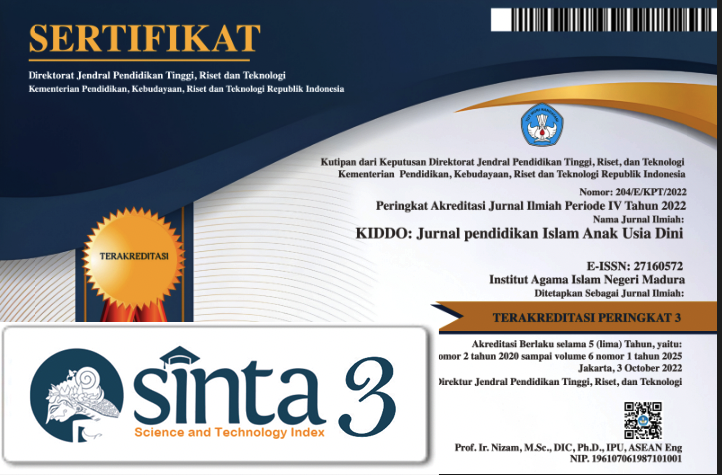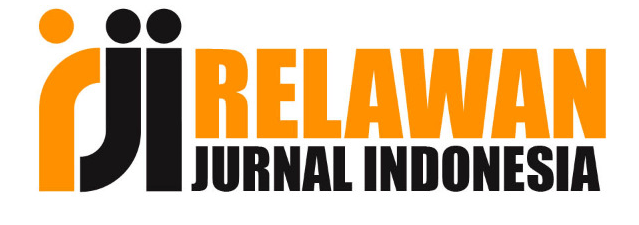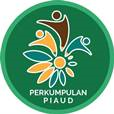The Use of Angklung As The Traditional Music Instrument to Stimulate The Artistic Skill of Preschoolers
 Abstract views: 244
,
Abstract views: 244
,
 PDF downloads: 173
PDF downloads: 173
Abstract
Music as an expression of the way children express their feelings through singing a song with loud and soft dynamics. The use of musical instruments such as angklung has become part of learning musical arts in most kindergarten due to the important of music that plays an essential role in a child's development particularly in art. This study aims to figure out the use of Angklung to increase the artistic skill of preschoolers in TK Kanisius Demangan Baru. The present study used qualitative method with descriptive approach. All data were collected from observations, documentations, and interviews with teachers and the school principal. Research findings indicate that playing angklung has a very good impact in improving children artistic. It was found that there are several artistic abilities that develop when learning angklung; being able to play the music instrument with good sound quality, suitability with the tempo, song pitch adjustment, mastery of the song rhythm, and being able to differentiate between good and bad musical tones. On top of that, the role of Angklung can enhance the sense of music to early childhood education.
Downloads
References
Andress, B. (1998). Music for young children. Fort Worth, TX: Harcourt Brace.
Aprilian, T.P.C., (2014). Kemampuan Kognitif Anak Dalam Aktivitas Seni Musik Di Kelompok B Tk Bhakti Siwi Soran. Journal UNY, Vol III No 7. Jogjakarta
Blašković, J., & Kuliš, A. (2017). Preschool Children ’ s Reactions to Active Music Listening through Movement , Visual Arts and Verbal Expression. Croatian Journal of Education, 19(3), 273–292.
Bogdan, R. C., & Biklen, K. S. (1982). Qualitative Research for Education: An Introduction to Theory and Methods. Allyn and Bacon, Inc.: Boston London.
Bolduc, J., & Evrard, M. (2016). Music education from birth to five: An examination of early childhood educators’ music teaching practices. Research & Issues in Music Education, 13(1), 1–20. https://bit.ly/3GvRnIf
Coppi, A. (2017). SEEING MUSIC, MUSIC TO SEE—Interdisciplinary Relations between Musical and Visual Art Education in Italian Pre-School and Primary School. 1079. https://doi.org/10.3390/proceedings1091079
Creswell, J. W. (2007). Qualitative inquiry & research design: Choosing among five approaches (2nd ed.). Thousand Oaks, CA: SageLin, X., Wu, J., Bashir, A. K., Li, J., Yang, W., & Piran, M. J. (2020). Blockchain-based incentive energyknowledge trading in IoT: Joint power transfer and AI design. IEEE Internet of Things Journal, 9(16), 14685– 14698. doi:10.1109/JIOT.2020.302424
Gordon, E. E. (2007). Learning sequences in music: A contemporary music learning theory. Chicago, IL: GIA Publications, Inc.
Muhammad, A., Araminta, N., & Lubis, H. Z. (2023). Enhancing Early Childhood Artistic Skills Through Angklung at Kindergarten. 3, 184–194. https://doi.org/10.31958/jies.v3i2.11574
Paula, A., Luz, M., & Almeida, I. P. De. (n.d.). Educador. Educação musical. Educador Multidisciplinar. 1748.
Pink, S., Horst, H., Postill, J., Hjorth, L., Lewis, T., & Tacchi, J. (2016). Digital Ethnography: Principles and Practice. SAGE Publications Ltd.
Ramdana, H. N., & Sari, N. P. (2020). Develop Aspect of the in Playing Traditional Angklung using a Combination Learning Models of Direct Instruction and Talking Sticks. Journal of K6 Education and Management, 3(3), 303–314. https://doi.org/10.11594/jk6em.03.03.03
Rosydiana, E. (2017). Meningkatkan Kecerdasan Musik Melalui Permainan Angklung Di Paud Aulia. Yaa Bunayya : Jurnal Pendidikan Anak Usia Dini, 1(2), 53–64.
Setyawati, T., Permanasari, A. T., & Yuniarti, T. C. E. (2017). MENINGKATKAN KECERDASAN MUSIKAL MELALUI BERMAIN ALAT MUSIK ANGKLUNG (Penelitian Tindakan Pada Anak Kelompok B Usia 5-6 Tahun di TK Negeri Pembina Kota Serang-Banten). Jurnal Pendidikan Dan Kajian Seni, 2(1), 63–77. https://doi.org/10.30870/jpks.v2i1.2503
Sudarto, S., Rahmawati, S., & Watini, S. (2023). Implementasi model ASYIK dalam mengembangkan kecerdasan musikal melalui kegiatan bermain angklung pada anak TK. Jurnal Pendidikan Anak, 12(2), 206–216.
Widjanarko, P., & Andaryani, E. T. (2022). Development of Music Intelligence in Paud Region of Surakarta Through the Angklung Game. Peer Reviewed International Journal, 14(11), 11–15. https://zienjournals.com
Widorini, L. I. S., Hasibuan, R., & Trihariastuti, R. (2019). The Effect of Angklung Musical Instrument on the Ability to Recognize Number Symbols and Fine Motorik of Children Aged 5-6 Years. International Journal of Trends in Mathematics Education Research, 2(1), 40–42. https://doi.org/10.33122/ijtmer.v2i1.122
Young, S. (2015). Early childhood music education research: An overview. Research Studies in Music Education, 38(1), 9–21. https://doi.org/10.1177/1321103X16640106
Zalar, K., Kordes, U., & Kafol, B. S. (2015). The Role of Children’s Musical Instruments in Communication with Musical Language. Procedia - Social and Behavioral Sciences, 197(February), 1326–1334. https://doi.org/10.1016/j.sbspro.2015.07.407
Copyright (c) 2024 Rahmawati Nur Alim

This work is licensed under a Creative Commons Attribution 4.0 International License.
-
The journal operates an Open Access policy under a Creative Commons 4.0 International license. The terms of the license are:
Share— copy and redistribute the material in any medium or format
Adapt— remix, transform, and build upon the material for any purpose, even commercially.
1. Authors retain copyright and grant the journal right of first publication with the work simultaneously licensed under a Creative Commons License.that allows others to share the work with an acknowledgement of the work’s authorship and initial publication in this journal
2. Authors are permitted and encouraged to post their work online (e.g., in institutional repositories or on their website) prior to and during the submission process, as it can lead to productive exchanges, as well as earlier and greater citation of published work (See The Effect of Open Access).
Jurnal Kiddo is licensed under a Creative Commons
n Access).














